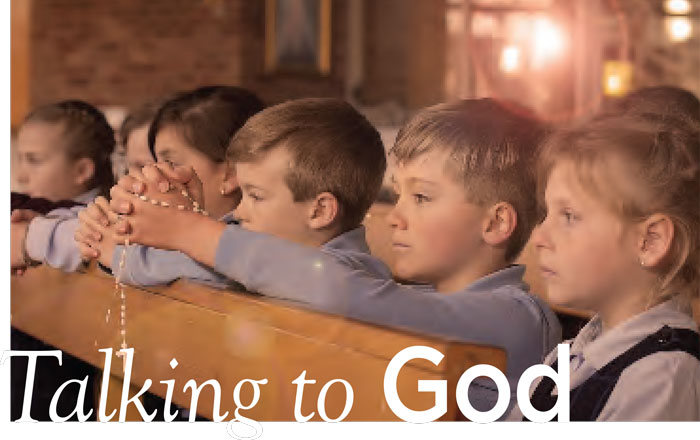Talking to God
 A Kindergarten teacher was leading morning prayer and finished with the ‘Our Father’. One of the children said they knew this prayer now ‘off by heart’ and would like to recite it by themselves. The teacher listened with pride as she carefully enunciated each word, right up to the end of the prayer. “Lead us not into temptation,” she prayed, “but deliver us some E-mail, Amen.”
A Kindergarten teacher was leading morning prayer and finished with the ‘Our Father’. One of the children said they knew this prayer now ‘off by heart’ and would like to recite it by themselves. The teacher listened with pride as she carefully enunciated each word, right up to the end of the prayer. “Lead us not into temptation,” she prayed, “but deliver us some E-mail, Amen.”
Prayer is a key element in not just the religious education program but the whole life of a Catholic school. Young children often give a very simple definition of prayer, namely ‘talking to God’. Although this is true to some degree, it does not portray the whole picture. Prayer, ultimately, is a relationship between ourselves and God. This relationship is encouraged, modelled and taught in classrooms as early as at our Early Learning Centres, and developed and sustained up until they leave high school.
Prayer in schools takes place in a variety of ways. We do know there is no ‘right’ way to pray and that people prefer to pray in different ways according to their life experiences and their personality. While schools have set times for students to pray, we do know that prayer cannot be timetabled all the time. Prayer needs to occur frequently and at appropriate times, but we also teach students that we spend time in prayer when required. An example may be a time of class sharing when the class learns that a member of the community is ill or perhaps there has been an argument between students during a playtime. This is an appropriate time for prayer because there is a need for students to stop and become aware of the presence of God within them and who God is calling them to be.
Our role as teachers in Catholic Schools is to offer regular opportunities for students to open their hearts to God. God is alive in us all anyway, but by praying we can know it. These are some ways schools promote prayer within individual classrooms:
Prayer space
Most classrooms have a prayer table or space. On these tables are Christian images and symbols – the crucifix, the open Bible etc. It allows a focal point for the room and for prayer time.
Silence
Christian Meditation can start in preschool and encourages students to be still and silent. Breathing and silent mantras can help during these times.
Scripture
Reading from the Bible is a great way for students to pray. To base, a prayer service around reading from the Gospels, or scripture from the Old Testament gives focus and meaning.
Prayers of Petition
Children can write very simple prayers of thanks, gratitude, praise and asking, and can learn to respond. Reflecting on their own lives, and praying for others in this way, is a powerful whole class exercise.
Education at home and school also needs to assist children to develop practices of reflection. A pause and prayer before a meal, a night prayer together, an expression of joy and thanks for the simple and beautiful things in life, a prayer to start or finish a journey, an expression of very real thanks for life on a birthday. These practices are but a few of the many ways we can lead our children to a deeper love of God in their lives.
This article was first published in My Family My Faith Magazine, 2016

David Austin, Principal, Good Shepherd Primary School – Amaroo



Prayer is our life,
Our children should be encouraged to think of the Lords Prayer as Jesus talking to God the Father in Heaven.
So, each time we are saying it, we are talking with Jesus: not he same language, but the aame prayer.